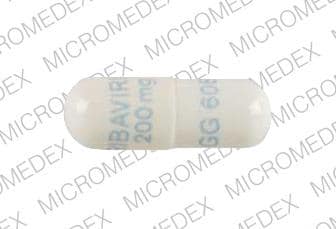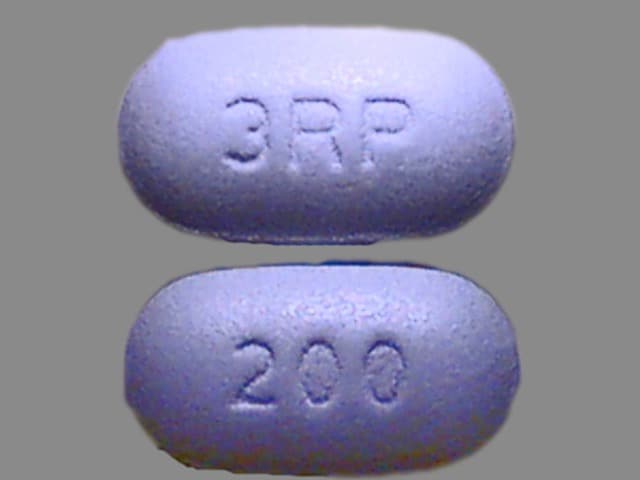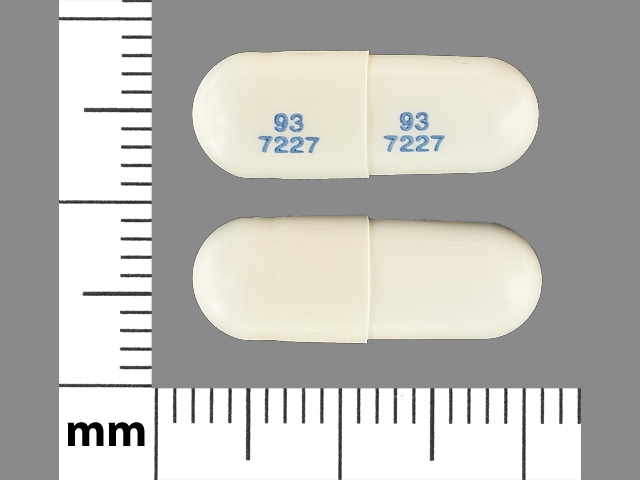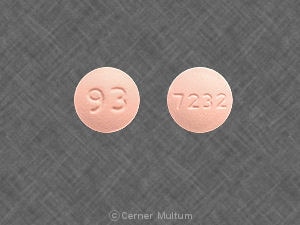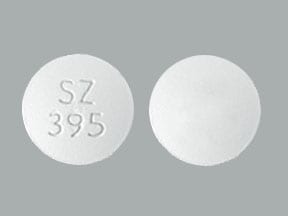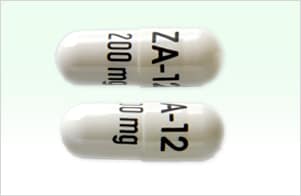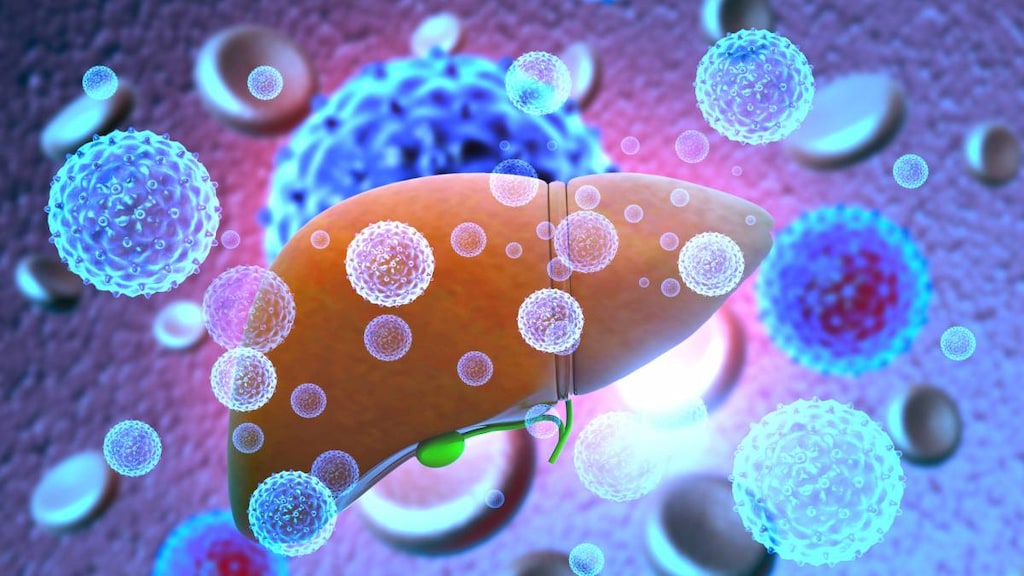Boxed Warning
Appropriate use:
Ribavirin monotherapy is not effective for the treatment of chronic hepatitis C virus (HCV) infection and should not be used alone for this indication.
Hemolytic anemia:
Hemolytic anemia has been reported with ribavirin therapy. The anemia associated with ribavirin therapy may result in worsening of cardiac disease that has led to fatal and nonfatal myocardial infarctions. Patients with a history of significant or unstable cardiac disease should not be treated with ribavirin
Pregnancy:
Significant teratogenic and embryocidal effects have been demonstrated in all animal species exposed to ribavirin. In addition, ribavirin has a multiple dose half-life of 12 days, and may persist in non-plasma compartments for as long as 6 months. Therefore, ribavirin therapy is contraindicated in women who are pregnant and in the male partners of women who are pregnant. Avoid pregnancy during therapy and for 6 months after completion of treatment in both female patients and female partners of male patients who are taking ribavirin therapy. Effective contraception must be utilized during treatment and during the 6-month post-treatment follow-up period.
Dosage Forms
Excipient information presented when available (limited, particularly for generics); consult specific product labeling. [DSC] = Discontinued product
Capsule, Oral:
Rebetol: 200 mg [DSC]
Ribasphere: 200 mg [DSC]
Generic: 200 mg
Solution, Oral:
Rebetol: 40 mg/mL (100 mL [DSC]) [contains propylene glycol, sodium benzoate; bubble-gum flavor]
Tablet, Oral:
Copegus: 200 mg [DSC]
Moderiba: 200 mg [DSC] [contains fd&c blue #2 aluminum lake]
Moderiba 1200 Dose Pack: 600 mg [DSC] [contains fd&c blue #1 aluminum lake]
Moderiba 800 Dose Pack: 400 mg [DSC] [contains fd&c blue #1 aluminum lake]
Ribasphere: 200 mg [DSC] [contains fd&c blue #2 aluminum lake]
Ribasphere: 400 mg [DSC], 600 mg [DSC] [contains fd&c blue #1 aluminum lake]
Generic: 200 mg
Tablet Therapy Pack, Oral:
Moderiba (1000 MG Pack): 400 mg & 600 mg (56 ea [DSC]) [contains fd&c blue #1 aluminum lake]
Moderiba (1200 MG Pack): 600 mg (56 ea [DSC]) [contains fd&c blue #1 aluminum lake]
Moderiba (600 MG Pack): 200 mg & 400 mg (56 ea [DSC]) [contains fd&c blue #1 aluminum lake, fd&c blue #2 aluminum lake]
Moderiba (800 MG Pack): 400 mg (56 ea [DSC]) [contains fd&c blue #1 aluminum lake]
Ribasphere RibaPak (1000 Pack): Ribasphere RibaPak 1000: 600 mg AM dose, 400 mg PM dose (14 ea [DSC], 56 ea [DSC]) [contains fd&c blue #1 aluminum lake]
Ribasphere Ribapak (1200 Pack): Ribasphere RibaPak 1200: 600 mg AM dose, 600 mg PM dose (14 ea [DSC], 56 ea [DSC]) [contains fd&c blue #1 aluminum lake]
Ribasphere RibaPak (600 Pack): Ribasphere RibaPak 600: 200 mg AM dose, 400 mg PM dose (14 ea [DSC], 56 ea [DSC]) [contains fd&c blue #1 aluminum lake, fd&c blue #2 aluminum lake]
Ribasphere RibaPak (800 Pack): Ribasphere RibaPak 800: 400 mg AM dose, 400 mg PM dose (14 ea [DSC], 56 ea [DSC]) [contains fd&c blue #1 aluminum lake]
RibaTab (1000 MG Pack): 400 mg & 600 mg (56 ea [DSC]) [contains fd&c blue #1 aluminum lake]
RibaTab (1200 MG Pack): 600 mg (56 ea [DSC]) [contains fd&c blue #1 aluminum lake]
RibaTab (800 MG Pack): 400 mg (56 ea [DSC]) [contains fd&c blue #1 aluminum lake]
Pharmacology
Mechanism of Action
Inhibits replication of RNA and DNA viruses; inhibits influenza virus RNA polymerase activity and inhibits the initiation and elongation of RNA fragments resulting in inhibition of viral protein synthesis
Pharmacokinetics/Pharmacodynamics
Distribution
Oral capsule: Single dose: Vd: 2,825 L; distribution significantly prolonged in the erythrocyte (16 to 40 days), which can be used as a marker for intracellular metabolism
Metabolism
Hepatically and intracellularly (forms active metabolites); may be necessary for drug action
Excretion
Oral capsule: Urine (61%), feces (12%)
Time to Peak
Serum: Oral capsule: Multiple doses: Children and Adolescents 3 to 16 years: ~2 hours; Adults: 3 hours; Tablet: 2 hours
Half-Life Elimination
Plasma: Adults:
Capsule, single dose: 24 hours in healthy adults, 44 hours with chronic hepatitis C infection (increases to ~298 hours at steady state)
Tablet, single dose: ~120 to 170 hours
Protein Binding
None
Use in Specific Populations
Special Populations: Renal Function Impairment
Capsules/Oral solution: The mean AUCtf value was 3-fold greater in subjects with CrCl values between 10 and 30 mL/minute compared with control subjects (CrCl >90 mL/minute). In subjects with CrCl values between 30 and 60 mL/minute, AUCtf was 2-fold greater compared with control subjects. Ribavirin is not effectively removed by hemodialysis.
Tablets: Clearance was reduced in patients with CrCl ≤50 mL/minute compared with patients with healthy renal function. Plasma exposure was decreased 20% in patients with ESRD on chronic hemodialysis.
Special Populations: Hepatic Function Impairment
Cmax increases with increasing severity of hepatic impairment.
Use: Labeled Indications
Hepatitis C virus infection, chronic: Ribavirin, in combination with direct-acting antivirals, is recommended in the AASLD/IDSA guidelines as part of an alternative regimen for certain clinical scenarios. Hepatitis C treatment guidelines are constantly changing with the advent of new treatment therapies and information; consult current clinical practice guidelines for the most recent treatment recommendations. The combination of peginterferon and ribavirin, even with additional preferred HCV antiviral agent(s), is not recommended for hepatitis C virus (HCV) (regardless of genotype) in HCV adult treatment guidelines (treatment-naive or treatment-experienced). Peginterferon and ribavirin-based regimens, however, may remain in use in resource-limited settings where interferon-free regimens are inaccessible or unavailable (AASLD/IDSA 2018).
Use: Off Label
Respiratory syncytial virus infection in immunocompromised patientsc
Data from non-randomized studies suggest that oral ribavirin with or without IVIG may be beneficial for the treatment of respiratory syncytial virus infection in immunocompromised patients Foolad 2018, Marcelin 2014, Piñana 2017, Spahr 2018, Trang 2018.
Viral hemorrhagic feverbyes
Data from a randomized trial support the utility of ribavirin for the treatment of viral hemorrhagic fever caused by Lassa virus McCormick 1986. Clinical experience suggests the utility of ribavirin for the treatment of viral hemorrhagic fevers caused by select Arenaviruses and Bunyaviruses Borio 2002. The World Health Organization’s Clinical Management of Patients with Viral Haemorrhagic Fever recommends the use of ribavirin for the treatment of Lassa fever and Crimean-Congo hemorrhagic fever; however, the use of ribavirin for the treatment of Crimean-Congo hemorrhagic fever is controversial Ceylan 2013, Ceylan 2014, Ergönül 2014, Ergönül 2018, Johnson 2018, Leblebicioglu 2019, WHO 2016.
Contraindications
Hypersensitivity to ribavirin or any component of the formulation; women who are pregnant or may become pregnant; males whose female partners are pregnant; patients with hemoglobinopathies (eg, thalassemia major, sickle cell anemia); concomitant use with didanosine
Ribasphere capsules and Rebetol capsules/solution: Additional contraindications: Patients with a CrCl <50 mL/minute
Combination therapy with alfa interferons: Autoimmune hepatitis; hepatic decompensation (Child-Pugh score >6; class B and C) in cirrhotic hepatitis C with or without HIV coinfection prior to treatment (Moderiba). Also refer to individual monographs for Interferon Alfa-2b (Intron A), Peginterferon Alfa-2b, and Peginterferon Alfa-2a (Pegasys) for additional contraindication information.
Dosage and Administration
Dosing: Adult
Hepatitis C virus infection, chronic:
Weight-based ribavirin:
<75 kg: 1 g daily in 2 divided doses (AASLD/IDSA 2018)
≥75 kg: 1.2 g daily in 2 divided doses (AASLD/IDSA 2018)
Low initial dose ribavirin: 600 mg; increase as tolerated (AASLD/IDSA 2018)
Dosing regimen, concomitant therapy, and duration is dependent on HCV genotype and treatment status (treatment-naive or treatment-experienced), as well as other factors (eg, presence and type of cirrhosis). Combination therapy with peginterferon is not recommended in HCV treatment guidelines (treatment-naive or treatment-experienced patients). Hepatitis C treatment guidelines are constantly changing with the advent of new treatment therapies and information; consult current AASLD/IDSA clinical practice guidelines for the most recent treatment recommendations (AASLD/IDSA 2018).
Respiratory syncytial virus infection in immunocompromised patients (off-label use): Oral: Optimal dosing has not been established: 600 to 800 mg 2 to 3 times daily (Foolad 2018; Marcelin 2014; Piñana 2017; Spahr 2018; Trang 2018) or a single 10 mg/kg loading dose followed by 20 mg/kg/day in 3 divided doses (Foolad 2018). Optimal duration is unknown, but most continue until clinical resolution (Foolad 2018; Piñana 2017; Spahr 2018). Note: Consider adjunctive IVIG for patients with hypogammaglobulinemia (Piñana 2017) and corticosteroids for lung transplant recipients (Trang 2018).
Viral hemorrhagic fever (off-label use): Note: The primary treatment is supportive care, but ribavirin may be used for patients with viral hemorrhagic fever secondary to select viruses (eg, Lassa) (Borio 2002). Use of ribavirin for Crimean-Congo hemorrhagic fever is controversial (Ceylan 2013; Ceylan 2014; Ergönül 2014; Ergönül 2018; Johnson 2018; WHO 2016).
Oral: 2 g loading dose followed by 1.2 g/day in 2 divided doses if weight >75 kg or 1 g/day in 2 divided doses if weight ≤75 kg (Borio 2002) or 35 mg/kg (maximum: 2.5 g/dose) loading dose followed by 15 mg/kg (maximum: 1 g/dose) every 6 hours for 4 days, followed by 15 mg/kg (maximum: 1 g/dose) every 8 hours for 6 days (Schieffelin 2019).
Dosing: Geriatric
Refer to adult dosing.
Dosing: Pediatric
Hepatitis C monoinfection, chronic:
AASLD/IDSA recommendations (AASLD/IDSA 2018): Note: Use in combination with sofosbuvir in patients (treatment-naive or treatment-experienced) with genotypes 2 or 3 without cirrhosis or with compensated cirrhosis; therapy duration: genotype 2: 12 weeks; genotype 3: 24 weeks.
Children <12 years weighing ≥35 kg and Children ≥12 years and Adolescents: Oral:
<47 kg: 15 mg/kg/day in 2 divided doses
47 to 49 kg: 600 mg/day in 2 divided doses
50 to 65 kg: 800 mg/day in 2 divided doses
66 to 80 kg: 1,000 mg/day in 2 divided doses
>80 kg: 1,200 mg/day in 2 divided doses
Manufacturer's labeling: Note: Dosing is based on product labeling and may not reflect current clinical practice. Guidelines recommend deferring treatment in pediatric patients until an interferon-free regimen can be prescribed (AASLD/IDSA 2018).
Capsule or oral solution (Rebetol, Ribasphere) in combination with pegylated or nonpegylated interferon alfa-2b: Note: Oral solution should be used in patients unable to swallow capsules:
Children ≥3 years and Adolescents: Oral:
<47 kg: 15 mg/kg/day in 2 divided doses
47 to 59 kg: 400 mg twice daily
60 to 73 kg: 400 mg in the morning; 600 mg in the evening
>73 kg: 600 mg twice daily
Tablets (Copegus, Moderiba, Ribasphere) in combination with peginterferon alfa-2a: Children ≥5 years and Adolescents able to swallow whole tablets: Oral:
23 to 33 kg: 200 mg twice daily
34 to 46 kg: 200 mg in the morning; 400 mg in the evening
47 to 59 kg: 400 mg twice daily
60 to 74 kg: 400 mg in the morning; 600 mg in the evening
≥75 kg: 600 mg twice daily
Dosing adjustment for toxicity: Oral:
Note: Based on manufacturer's labeling, when used in combination with pegylated or nonpegylated interferon alfa-2b. Children ≥3 years and Adolescents: Once a laboratory abnormality or clinical adverse event has resolved, the ribavirin dose may be increased, based on clinical judgment, to its original assigned dose or restarted at 50% of the full dose.
Patient without cardiac history:
Hemoglobin 8.5 to <10 g/dL:
Capsules, oral solution: Children ≥3 years and Adolescents: Decrease ribavirin dose to 12 mg/kg/day; may further reduce to 8 mg/kg/day
Tablets: Children ≥5 years and Adolescents:
23 to 33 kg: Decrease dose to 200 mg once daily in the morning
34 to 59 kg: Decrease dose to 200 mg twice daily
≥60 kg: Decrease dose to 200 mg in the morning and 400 mg in the evening
Hemoglobin <8.5 g/dL: Children ≥3 years and Adolescents: Oral capsules, oral solution, tablets: Discontinue ribavirin.
WBC <1,000 mm3, neutrophils <500 mm3: Children ≥3 years and Adolescents: Oral capsules, oral solution, tablets: Discontinue treatment.
Platelets <50 x 109/L: Children ≥3 years and Adolescents: Oral capsules, oral solution, tablets: Discontinue treatment.
Patient with cardiac history:
Hemoglobin decrease ≥2 g/dL in any 4-week period of treatment:
Capsules, oral solution: Children ≥3 years and Adolescents: Decrease by 200 mg daily (regardless of the patient's initial dose); monitor and evaluate weekly
Tablets: Children ≥5 years and Adolescents:
23 to 33 kg: Decrease dose to 200 mg once daily in the morning
34 to 59 kg: Decrease dose to 200 mg twice daily
≥60 kg: Decrease to 200 mg in the morning and 400 mg in the evening
Hemoglobin <12 g/dL after 4 weeks of reduced dose: Children ≥3 years and Adolescents: Capsules, oral solution, tablets: Discontinue ribavirin
Hemoglobin <8.5 g/dL: Children ≥3 years and Adolescents: Oral capsules, oral solution, tablets: Discontinue ribavirin
WBC <1,000 mm3, neutrophils <500 mm3: Children ≥3 years and Adolescents: Oral capsules, oral solution, tablets: Discontinue treatment.
Platelets <50 x 109/L: Children ≥3 years and Adolescents: Oral capsules, oral solution, tablets: Discontinue treatment.
Dosing: Adjustment for Toxicity
Note: Once ribavirin has been withheld due to clinical adverse event or laboratory abnormality, an attempt can be made to restart ribavirin, in divided doses, at 600 mg daily, with a further ribavirin increase to 800 mg daily. Increasing the ribavirin dose to its original assigned dose (1,000 to 1,200 mg daily) is not recommended.
Patient without cardiac history:
Hemoglobin 8.5 to <10 g/dL:
Oral capsules, oral solution:
First reduction: ≤105 kg: Decrease by 200 mg daily; >105 kg: Decrease by 400 mg daily
Second reduction: Decrease by an additional 200 mg daily (not weight-based)
Oral tablets: Decrease dose to 600 mg daily (200 mg in the morning, 400 mg in the evening)
Hemoglobin <8.5 g/dL: Oral capsules, solution, tablets: Permanently discontinue treatment.
WBC <1,000 mm3, neutrophils <500 mm3: Oral capsules, solution: Permanently discontinue treatment.
Platelets <25 x 109/L: Oral capsules, solution: Permanently discontinue treatment.
Laboratory abnormalities or adverse reactions other than decreased hemoglobin: Oral tablets: Refer to dose modification guidelines in the manufacturer's labeling.
Patient with stable cardiac history:
Hemoglobin has decreased ≥2 g/dL during any 4-week period of treatment:
Oral capsules, solution: Decrease dose by 200 mg daily; decrease peginterferon alfa-2b dose by 50%. If hemoglobin <8.5 g/dL any time after dose reduction or <12 g/dL after 4 weeks of dose reduction, permanently discontinue treatment.
Oral tablets: Decrease dose to 600 mg daily (200 mg in the morning, 400 mg in the evening). If hemoglobin <8.5 g/dL any time after dose reduction or <12 g/dL after 4 weeks of dose reduction, permanently discontinue treatment.
Hemoglobin <8.5 g/dL: Oral capsules, solution, tablets: Permanently discontinue treatment.
WBC <1,000 mm3, neutrophils <500 mm3: Oral capsules, solution: Permanently discontinue treatment.
Platelets <25 x 109/L: Oral capsules, solution: Permanently discontinue treatment.
Laboratory abnormalities or adverse reactions other than decreased hemoglobin: Oral tablets: Refer to dose modification guidelines in the manufacturer's labeling.
Administration
Oral:
Capsule: Administer with food. Capsule should not be opened, crushed, or broken.
Solution: Administer with food.
Dietary Considerations
Capsules, solution, and tablets should be taken with food.
Storage
Store at 25°C (77°F); excursions permitted between 15°C and 30°C (59°F and 86°F). Solution may also be refrigerated at 2°C to 8°C (36°F to 46°F).
Ribavirin (Systemic) Images
Drug Interactions
AzaTHIOprine: Ribavirin (Systemic) may increase serum concentrations of the active metabolite(s) of AzaTHIOprine. Specifically, concentrations of potentially myelotoxic methylated metabolites may be increased, while concentrations of active 6-thioguanine nucleotides may be decreased. Management: Consider using alternative agent(s) when possible. When these drugs are used in combination, monitor patients closely for signs/symptoms of myelosuppression. Consider therapy modification
Cladribine: Agents that Undergo Intracellular Phosphorylation may diminish the therapeutic effect of Cladribine. Avoid combination
Didanosine: Ribavirin (Systemic) may enhance the adverse/toxic effect of Didanosine. Ribavirin (Systemic) may increase serum concentrations of the active metabolite(s) of Didanosine. Avoid combination
Influenza Virus Vaccine (Live/Attenuated): Antiviral Agents (Influenza A and B) may diminish the therapeutic effect of Influenza Virus Vaccine (Live/Attenuated). Management: Avoid anti-influenza antivirals during the period beginning 48 hours prior to and ending 2 weeks after live influenza virus vaccine administration. Consider therapy modification
Interferons (Alfa): May enhance the adverse/toxic effect of Ribavirin (Systemic). Hemolytic anemia has been observed. Monitor therapy
Vitamin K Antagonists (eg, warfarin): Ribavirin (Systemic) may diminish the anticoagulant effect of Vitamin K Antagonists. Monitor therapy
Zidovudine: May enhance the adverse/toxic effect of Ribavirin (Systemic). Specifically, the risk/severity of anemia may be increased. Management: Due to significantly increased risk of anemia, consider even closer monitoring for anemia than routinely recommended for ribavirin. Alternative therapies should be considered when clinically possible, particularly for patients with other risk factors. Consider therapy modification
Adverse Reactions
Clinical trials were conducted in patients receiving peginterferon alfa-2a, peginterferon alfa-2b and interferon alfa-2b, and it is not possible to correlate frequency of adverse events with ribavirin alone. Moreover, ribavirin monotherapy is not an effective treatment for chronic hepatitis.
>10%:
Central nervous system: Headache (41% to 69%), fatigue (≤68%; children & adolescents: 25% to 58%), rigors (25% to 48%; children & adolescents: 25%), anxiety (≤47%), emotional lability (≤47%; children & adolescents: 16%), irritability (≤47%; children & adolescents: 10% to 24%), insomnia (26% to 41%; children & adolescents: 9% to 14%), depression (≤40%; children & adolescents: 1% to 14%), chills (23% to 39%; children & adolescents: 21%), nervousness (≤38%; children & adolescents: 3% to 7%), dizziness (13% to 26%), lack of concentration (10% to 21%; children & adolescents: 5%), pain (9% to 13%), right upper quadrant pain (6% to 12%)
Dermatologic: Dermatological disease (children & adolescents: 47%), alopecia (17% to 36%; children & adolescents: 17% to 23%), skin rash (5% to 34%; children & adolescents: 15% to 17%), pruritus (13% to 29%; children & adolescents: 11% to 12%), xeroderma (10% to 24%), dermatitis (13% to 16%), diaphoresis (5% to 11%)
Endocrine & metabolic: Growth suppression (children & adolescents: <3rd percentile height decrease: 70%, >15 percentile height or weight decrease: 11% to 43%, >30 percentile height decrease: ≤13%), weight loss (10% to 29%; children & adolescents: 16% to 19%)
Gastrointestinal: Gastrointestinal disease (children & adolescents: 49% to 56%), anorexia (21% to 32%; children & adolescents: 29% to 51%), nausea (≤47%; children & adolescents: 18% to 33%), vomiting (≤29%; children & adolescents: 27% to 42%), decreased appetite (children & adolescents: 11% to 22%), diarrhea (10% to 22%), abdominal pain (8% to 21%), dyspepsia (5% to 16%; children & adolescents: <1%), upper abdominal pain (children & adolescents: 12%), xerostomia (4% to 12%)
Hematologic & oncologic: Neutropenia (8% to 40%), anemia (11% to 35%; children & adolescents: 11%), lymphocytopenia (12% to 14%), hemolytic anemia (13%)
Hepatic: Increased serum bilirubin (1.5 to 3 mg/dL: 10% to 32%, 3.1 to 12 mg/dL: ≤3%; children & adolescents: 1.26 to 2.59 x ULN: 7%, 1.5 to 3 mg/dL: 2%)
Infection: Viral infection (12%)
Local: Injection site reaction (5% to 58%; children & adolescents: 19% to 45%), erythema at injection site (children & adolescents: 29%), inflammation at injection site (13% to 25%; children & adolescents: 14%)
Neuromuscular & skeletal: Weakness (≤68%; children & adolescents: 5% to 15%), myalgia (22% to 64%; children & adolescents: 17% to 32%), musculoskeletal pain (19% to 21%; children & adolescents: 21% to 35%), arthralgia (21% to 34%; children & adolescents: 15% to 17%)
Respiratory: Flu-like symptoms (15% to 16%; children & adolescents: 31% to 91%), upper respiratory tract infection (children & adolescents: 60%), dyspnea (13% to 26%; children & adolescents: 5%), cough (7% to 23%), pharyngitis (12% to 13%), sinusitis (5% to 12%; children & adolescents: <1%)
Miscellaneous: Fever (21% to 55%; children % adolescents: 61% to 80%), drug tolerance (12%)
1% to 10%:
Cardiovascular: Chest pain (5% to 9%), flushing (3% to 4%)
Central nervous system: Mood disorder (5% to 9%), agitation (5% to 8%), memory impairment (5% to 6%), malaise (4% to 6%), high fever (children & adolescents: 4%), aggressive behavior (children & adolescents: 3%), hostility (children & adolescents: 2%), suicidal ideation (≤2%), severe headache (children & adolescents: 1%)
Dermatologic: Eczema (4% to 5%)
Endocrine & metabolic: Menstrual disease (6% to 7%), hypothyroidism (4% to 5%)
Gastrointestinal: Dysgeusia (4% to 9%; children & adolescents: <1%), constipation (5%), liver decompensation (2%)
Hematologic & oncologic: Leukopenia (5% to 10%), thrombocytopenia (≤8%), severe neutropenia (children & adolescents: 1%)
Hepatic: Increased serum ALT (2.1 to 5 x baseline: 1% to 5%; 5.1 x 10 x baseline: 3%; 2 x baseline: ≤1%), hepatomegaly (4%)
Infection: Fungal infection (1% to 6%)
Local: Pain at injection site (children & adolescents: 1%; severe)
Neuromuscular & skeletal: Back pain (5%), limb pain (children & adolescents: 1%; severe)
Ophthalmic: Blurred vision (2% to 6%), conjunctivitis (4% to 5%)
Respiratory: Rhinitis (6% to 8%), dyspnea on exertion (4% to 7%)
Frequency not defined: Hematologic & oncologic: Hemolysis
<1%, postmarketing and/or case reports: Anaphylaxis, angioedema, aplastic anemia, auditory disorder, autoimmune disease, bacterial infection, bone marrow depression, bronchoconstriction, cerebrovascular disease, colitis, dehydration, dental disease, diabetes mellitus, drug overdose, exacerbation of sarcoidosis, exfoliative dermatitis, gout, graft rejection (kidney, liver), hearing loss, homicidal ideation, hypersensitivity reaction, infection, lactic acidosis (Smith 2019), ophthalmologic signs and symptoms, pancreatitis, periodontal disease, pneumonia, pneumonitis, pulmonary disease, pulmonary hypertension, pulmonary infiltrates, pure red cell aplasia, relapse of drug dependence, retinal detachment (serous), sarcoidosis, severe depression, Stevens-Johnson syndrome, toxic epidermal necrolysis, urticaria, vertigo, vesiculobullous dermatitis
Warnings/Precautions
Concerns related to adverse effects:
- Hemolytic anemia: [US Boxed Warning]: Hemolytic anemia has been reported with ribavirin therapy; anemia associated with ribavirin may worsen underlying cardiac disease and lead to fatal and nonfatal myocardial infarctions. Avoid use in patients with significant/unstable cardiac disease. Anemia usually occurs within 1 to 2 weeks of therapy initiation; observed in ~10% to 13% of patients when alfa interferons were combined with ribavirin. Assess cardiac function before initiation of therapy. If patient has underlying cardiac disease, assess electrocardiogram prior to and periodically during treatment. If any deterioration in cardiovascular status occurs, discontinue therapy. Use caution in patients with baseline risk of severe anemia. Assess hemoglobin and hematocrit at baseline and, at minimum, weeks 2 and 4 of therapy since initial drop may be significant. Patients with renal dysfunction and/or those >50 years of age should be carefully assessed for development of anemia.
Disease-related concerns:
- Hepatic impairment: Risk of hepatic decompensation in chronic hepatitis C patients treated with combination therapy; monitor hepatic function closely and discontinue therapy immediately if evidence of hepatic decompensation is observed.
- Hepatitis C: Appropriate use: [US Boxed Warning]: Ribavirin monotherapy is not effective for chronic hepatitis C infection and should not be used alone for hepatitis C.
- Renal impairment: Use with caution in patients with renal impairment; dosage adjustment or discontinuation may be required.
Concurrent drug therapy issues:
Combination therapy with alfa interferons:
- Autoimmune/infectious disorders: Have occurred with combination therapy; use with caution in patients with autoimmune disease or severe infection.
- Bone marrow suppression: Pancytopenia has occurred with combination therapy and concomitant use of azathioprine; onset occurs within 3 to 7 weeks; discontinue combination therapy and azathioprine if pancytopenia occurs; may be reversible (usually within 4 to 6 weeks).
- Dental and periodontal disorders: Have been reported with combination therapy; patients should be instructed to brush teeth twice daily and have regular dental exams. Xerostomia may contribute to and/or exacerbate dental disorders.
- Dermatologic reactions: Severe cutaneous reactions, including Stevens-Johnson syndrome and exfoliative dermatitis have been reported (rarely) with combination therapy; discontinue immediately with signs or symptoms of severe skin reactions.
- Diabetes: Has occurred with combination therapy; monitor blood sugars closely.
- Hypersensitivity reactions: Acute hypersensitivity reactions (eg, anaphylaxis, angioedema, bronchoconstriction, and urticaria) have been observed with combination therapy; discontinue immediately with signs or symptoms of severe hypersensitivity reactions.
- Ophthalmologic disorders: Serious disorders (eg, retinopathy, macular edema, retinal artery/vein thrombosis, optic neuritis, retinal detachment) have occurred with combination therapy. All patients require an eye exam at baseline; those with preexisting ophthalmologic disorders (eg, diabetic or hypertensive retinopathy) require periodic follow up. Discontinue therapy in patients with new or worsening ophthalmologic disorders.
- Pancreatitis: Has occurred with combination therapy; interrupt therapy if pancreatitis is suspected and discontinue if confirmed.
- Psychiatric disorders: Severe psychiatric events have occurred including depression and suicidal/homicidal ideation during combination therapy. Suicidal ideation or attempts occurred more often in pediatric patients versus reports in adults during treatment and off-therapy follow-up (2.4% vs 1%). Avoid use in patients with a psychiatric history; discontinue if severe psychiatric symptoms occur.
- Pulmonary events: Pulmonary symptoms (eg, dyspnea, pulmonary infiltrates, pneumonitis, pulmonary hypertension, and pneumonia [rarely fatal]) have been associated with combination therapy; use with caution in patients with pulmonary disease, including sarcoidosis (exacerbation reported).
Special populations:
- Elderly: Use with caution in the elderly; may be more susceptible to adverse effects such as anemia. Monitor renal function closely.
- Pediatric: In combination therapy with alfa interferons, ribavirin may cause a reduction in growth velocity in pediatric and adolescent patients 5 to 17 years of age for the length of treatment. Delay in weight and height increases have been noted in pediatric patients treated with combination therapy. In clinical studies, decreases were noted in weight and height for age z-scores and normative growth curve percentiles. Following treatment, rebound growth and weight gain occurred in most patients; however, a small percentage did not. Long-term data indicate that combination therapy may inhibit growth resulting in reduced adult height in some patients. Growth should be closely monitored in pediatric patients during therapy and post-treatment for growth catch-up.
- Pregnancy: [US Boxed Warning]: Use is contraindicated in pregnant females or male partners of pregnant females. Significant teratogenic and/or embryocidal effects have been observed in all animal studies. Avoid pregnancy in female patients and female partners of male patients during therapy; use effective contraceptive measures during treatment and for at least 6 months after completion of therapy.
Dosage form specific issues:
- Benzyl alcohol and derivatives: Some dosage forms may contain sodium benzoate/benzoic acid; benzoic acid (benzoate) is a metabolite of benzyl alcohol; large amounts of benzyl alcohol (≥99 mg/kg/day) have been associated with a potentially fatal toxicity ("gasping syndrome") in neonates; the "gasping syndrome" consists of metabolic acidosis, respiratory distress, gasping respirations, CNS dysfunction (including convulsions, intracranial hemorrhage), hypotension, and cardiovascular collapse (AAP ["Inactive" 1997]; CDC 1982); some data suggest that benzoate displaces bilirubin from protein binding sites (Ahlfors 2001); avoid or use dosage forms containing benzyl alcohol derivative with caution in neonates. See manufacturer's labeling.
Other warnings/precautions:
- Appropriate use: Safety and efficacy have not been established in patients who have failed previous interferon therapy, received organ transplants, or been coinfected with hepatitis B or HIV (ribavirin tablets may be used in adult HIV-coinfected patients with clinically stable disease and CD4+ cell count >100 cells/mm3). The combination of peginterferon and ribavirin, even with additional preferred HCV antiviral agent(s), is not recommended for hepatitis C virus (HCV) (regardless of genotype) in HCV adult treatment guidelines (treatment-naive or treatment-experienced); consult current clinical practice guidelines for details on appropriate use (AASLD/IDSA 2018).
Monitoring Parameters
Manufacturer’s labeling:
Pretreatment hematological and biochemical tests are recommended for all patients; dental exam, ECG (if preexisting cardiac abnormalities or disease) and ophthalmic exam (also periodically during treatment for those with preexisting ophthalmologic disorders) are also recommended. In adults, hematologic tests should be performed at treatment weeks 2 and 4, biochemical tests at week 4, and TSH every 12 weeks.
Pregnancy testing: Evaluate pregnancy status prior to use in females of reproductive potential. A negative pregnancy test is required immediately before initiation, periodically during therapy, and during the 6 months after treatment is discontinued.
In pediatric clinical studies, hematologic and biochemical assessments were made at weeks 1, 3, 5 and 8, then every 4 weeks thereafter, and TSH every 12 weeks. Growth velocity and weight should also be monitored during and periodically after treatment discontinuation.
Serum HCV RNA (pretreatment, week 12 and week 24, and 24 weeks after completion of therapy).
Baseline values used in adult clinical trials in combination with alfa interferons:
Platelet count ≥90,000/mm3 (75,000/mm3 for cirrhosis or 70,000/mm3 for coinfection with HIV)
ANC ≥1,500/mm3
Hemoglobin ≥12 g/dL for women and ≥13 g/dL for men (11 g/dL for HIV coinfected women and 12 g/dL for HIV coinfected men)
TSH and T4 within normal limits or adequately controlled
CD4+ cell count ≥200 cells/microL or CD4+ cell count 100 to 200 cells/microL and HIV-1 RNA <5,000 copies/mL for coinfection with HIV
Alternate recommendations (AASLD/IDSA 2018):
Baseline (within 12 weeks prior to starting antiviral therapy): CBC, INR, hepatic function panel (albumin, total and direct bilirubin, ALT, AST, and alkaline phosphatase), calculated GFR
Baseline (at any time prior to starting antiviral therapy): HCV genotype and subtype, quantitative HCV viral load
Pregnancy screening prior to therapy (in females of reproductive potential); assessment of pregnancy status and contraceptive use in female patients of reproductive potential and female partners of male patients
During therapy: CBC, serum creatinine, calculated GFR, hepatic function panel (after 4 weeks of therapy and as clinically indicated); quantitative HCV viral load testing (after 4 weeks of therapy and at 12 weeks after completion of therapy). If quantitative HCV viral load is detectable at treatment week 4, repeat testing is recommended after 2 additional weeks of treatment (treatment week 6).
Pregnancy
Pregnancy Considerations
[US Boxed Warning]: Significant teratogenic and embryocidal effects have been demonstrated in all animal species exposed to ribavirin. In addition, ribavirin has a multiple dose half-life of 12 days, and may persist in non-plasma compartments for as long as 6 months. Therefore, ribavirin therapy is contraindicated in women who are pregnant and in the male partners of women who are pregnant. Use is also contraindicated in females who may become pregnant. Preliminary data from the Ribavirin Pregnancy Registry is available but given slow enrollment insufficient to draw conclusions related to teratogenic effects in humans (Sinclair 2017).
Treatment of hepatitis C is not currently recommended to treat maternal infection or to decrease the risk of mother-to-child transmission during pregnancy (Tran 2016). HCV-infected females of childbearing potential should consider postponing pregnancy until therapy is complete to reduce the risk of HCV transmission (AASLD/IDSA 2018).
[US Boxed Warning]: Avoid pregnancy during therapy and for 6 months after completion of treatment in both female patients and female partners of male patients who are taking ribavirin therapy. Effective contraception must be utilized during treatment and during the 6-month post-treatment follow-up period. Evaluate pregnancy status prior to use in females of reproductive potential. A negative pregnancy test is required immediately before initiation, periodically during therapy, and during the 6 months after treatment is discontinued. If patient or female partner becomes pregnant during treatment, she should be counseled about potential risks of exposure. Concentrations of ribavirin are higher in seminal fluid than serum in male patients treated for HCV infection; in addition, alterations in spermatogenesis have been noted (Sinclair 2017).
Health care providers and patients are encouraged to enroll females exposed to ribavirin during pregnancy or within 6 months after treatment in the Ribavirin Pregnancy Registry (800-593-2214).
Patient Education
What is this drug used for?
- It is used to treat hepatitis C infection.
- This drug may be used along with interferon or peginterferon. If you are using one of these drugs, read the patient fact sheet that comes with it.
Frequently reported side effects of this drug
- Flu-like symptoms
- Trouble sleeping
- Nausea
- Vomiting
- Constipation
- Diarrhea
- Lack of appetite
- Abdominal pain
- Hair loss
- Joint pain
- Muscle pain
- Dizziness
- Weight loss
- Dry skin
- Dry mouth
Other side effects of this drug: Talk with your doctor right away if you have any of these signs of:
- Pancreatitis like severe abdominal pain, severe back pain, severe nausea, or vomiting.
- Depression like thoughts of suicide, anxiety, emotional instability, or confusion.
- Agitation
- Panic attacks
- Irritability
- Mood changes
- Behavioral changes
- Infection
- Severe loss of strength and energy
- Chest pain
- Confusion
- Vision changes
- Blindness
- Pale skin
- Inability to focus
- Hemolytic anemia like severe loss of strength and energy, dark urine, or yellow skin.
- Severe pulmonary disorder like lung or breathing problems like difficulty breathing, shortness of breath, or a cough that is new or worse.
- Stevens-Johnson syndrome/toxic epidermal necrolysis like red, swollen, blistered, or peeling skin (with or without fever); red or irritated eyes; or sores in mouth, throat, nose, or eyes.
- Bleeding
- Bruising
- Signs of a significant reaction like wheezing; chest tightness; fever; itching; bad cough; blue skin color; seizures; or swelling of face, lips, tongue, or throat.
Note: This is not a comprehensive list of all side effects. Talk to your doctor if you have questions.
Consumer Information Use and Disclaimer: This information should not be used to decide whether or not to take this medicine or any other medicine. Only the healthcare provider has the knowledge and training to decide which medicines are right for a specific patient. This information does not endorse any medicine as safe, effective, or approved for treating any patient or health condition. This is only a brief summary of general information about this medicine. It does NOT include all information about the possible uses, directions, warnings, precautions, interactions, adverse effects, or risks that may apply to this medicine. This information is not specific medical advice and does not replace information you receive from the healthcare provider. You must talk with the healthcare provider for complete information about the risks and benefits of using this medicine.
